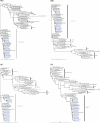Emergence of H5N1 avian influenza viruses with reduced sensitivity to neuraminidase inhibitors and novel reassortants in Lao People's Democratic Republic
- PMID: 20016036
- PMCID: PMC2888158
- DOI: 10.1099/vir.0.017459-0
Emergence of H5N1 avian influenza viruses with reduced sensitivity to neuraminidase inhibitors and novel reassortants in Lao People's Democratic Republic
Abstract
Pandemic influenza viruses can emerge through continuous evolution and the acquisition of specific mutations or through reassortment. This study assessed the pandemic potential of H5N1 viruses isolated from poultry outbreaks occurring from July 2006 to September 2008 in the Lao People's Democratic Republic (PDR). We analyzed 29 viruses isolated from chickens and ducks and two from fatal human cases in 2007. Prior to 2008, all H5N1 isolates in Lao PDR were from clade 2.3.4; however, clade 2.3.2 was introduced in September 2008. Of greatest concern was the circulation of three isolates that showed reduced sensitivity to the neuraminidase (NA) inhibitor oseltamivir in an enzyme inhibition assay, each with different NA mutations - V116A, I222L and K150N, and a previously unreported S246N mutation. In addition, six isolates had an S31N mutation in the M2 protein, which conferred resistance to amantadine not previously reported in clade 2.3.4 viruses. Two H5N1 reassortants were isolated whose polymerase genes, PB1 and PB2, were homologous to those of Eurasian viruses giving rise to a novel H5N1 genotype, genotype P. All H5N1 viruses retained avian-like receptor specificity, but four had altered affinities for alpha2,3-linked sialic acid. This study shows that, in a genetically similar population of H5N1 viruses in Lao PDR, mutants emerged with natural resistance to antivirals and altered affinities for alpha2,3-linked sialic acids, together with reassortants with polymerase genes homologous to Eurasian viruses. These changes may contribute to the emergence of a pandemic influenza strain and are critical in devising surveillance strategies.
Figures




References
-
- Cheung, C. L., Rayner, J. M., Smith, G. J., Wang, P., Naipospos, T. S., Zhang, J., Yuen, K. Y., Webster, R. G., Peiris, J. S. & other authors (2006). Distribution of amantadine-resistant H5N1 avian influenza variants in Asia. J Infect Dis 193, 1626–1629. - PubMed
-
- de Jong, M. D., Tran, T. T., Truong, H. K., Vo, M. H., Smith, G. J., Nguyen, V. C., Bach, V. C., Phan, T. Q., Do, Q. H. & other authors (2005). Oseltamivir resistance during treatment of influenza A (H5N1) infection. N Engl J Med 353, 2667–2672. - PubMed
Publication types
MeSH terms
Substances
Associated data
- Actions
- Actions
- Actions
- Actions
- Actions
- Actions
- Actions
- Actions
- Actions
- Actions
- Actions
- Actions
- Actions
- Actions
- Actions
- Actions
- Actions
- Actions
- Actions
- Actions
- Actions
- Actions
- Actions
- Actions
- Actions
- Actions
- Actions
- Actions
- Actions
- Actions
- Actions
- Actions
- Actions
- Actions
- Actions
- Actions
- Actions
- Actions
- Actions
- Actions
- Actions
- Actions
- Actions
- Actions
- Actions
- Actions
- Actions
- Actions
- Actions
- Actions
- Actions
- Actions
- Actions
- Actions
- Actions
- Actions
- Actions
- Actions
- Actions
- Actions
- Actions
- Actions
- Actions
- Actions
- Actions
- Actions
- Actions
- Actions
- Actions
- Actions
- Actions
- Actions
- Actions
- Actions
- Actions
- Actions
- Actions
- Actions
- Actions
- Actions
- Actions
- Actions
- Actions
- Actions
- Actions
- Actions
- Actions
- Actions
- Actions
- Actions
- Actions
- Actions
- Actions
- Actions
- Actions
- Actions
- Actions
- Actions
- Actions
- Actions
- Actions
- Actions
- Actions
- Actions
- Actions
- Actions
- Actions
- Actions
- Actions
- Actions
- Actions
- Actions
- Actions
- Actions
- Actions
- Actions
- Actions
- Actions
- Actions
- Actions
- Actions
- Actions
- Actions
- Actions
- Actions
- Actions
- Actions
- Actions
- Actions
- Actions
- Actions
- Actions
- Actions
- Actions
- Actions
- Actions
- Actions
- Actions
- Actions
- Actions
- Actions
- Actions
- Actions
- Actions
- Actions
- Actions
- Actions
- Actions
- Actions
- Actions
- Actions
- Actions
- Actions
- Actions
- Actions
- Actions
- Actions
- Actions
- Actions
- Actions
- Actions
- Actions
- Actions
- Actions
- Actions
- Actions
- Actions
- Actions
- Actions
- Actions
- Actions
- Actions
- Actions
- Actions
- Actions
- Actions
- Actions
- Actions
- Actions
- Actions
- Actions
- Actions
- Actions
- Actions
- Actions
- Actions
- Actions
- Actions
- Actions
- Actions
- Actions
- Actions
- Actions
- Actions
- Actions
- Actions
- Actions
Grants and funding
LinkOut - more resources
Full Text Sources
Miscellaneous

